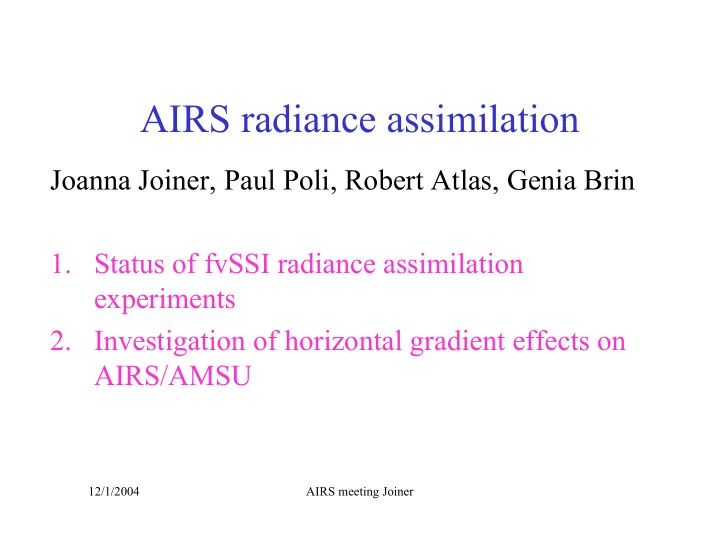

AIRS radiance assimilation Joanna Joiner, Paul Poli, Robert Atlas, Genia Brin 1. Status of fvSSI radiance assimilation experiments 2. Investigation of horizontal gradient effects on AIRS/AMSU 12/1/2004 AIRS meeting Joiner
AIRS radiance assimilation setup • All experiment use fvSSI system (T62L64, model 1x1.25 o ) – Finite-volume general circulation model (GMAO) – Spectral Statistical Interpolation (SSI) analysis (NCEP) – Modifications to accept AIRS data preprocessed at NASA/GSFC (thinned, cloud-detected, cloud-cleared) – Added new version of OPTRAN (faster) • Can run 6 week experiment (2 week spin-up), forecasts daily for 30 days in ~5 days • Have completed several experiments 12/1/2004 AIRS meeting Joiner
Monthly averaged scores Black: control; Red: AIRS standard weights; Green: Increased weights Thinned: warmest of 9 pixels 12/1/2004 AIRS meeting Joiner
Monthly averaged scores Black: control; Red: AIRS standard weights; Green: GSFC cloud detection Note: Similar results with cloud- cleared data (not optimized) 12/1/2004 AIRS meeting Joiner
5-day daily scores for Jan. 2003 Black: control; Red: AIRS standard weights; Green: GSFC cloud detection Notes: 1) Need more statistical analysis to determine significance 2) Setup needs further checking 12/1/2004 AIRS meeting Joiner
Effect of horizontal gradients on AIRS and AMSU brightness temperatures 12/1/2004 AIRS meeting Joiner
Accounting for effects of horizontal gradients for AIRS/AMSU • Use hybrid analysis (NCEP in the troposphere, GMAO in stratosphere and above, GMAO off-line ozone analysis, 1x1.25 o ) • Using appropriate geometry (rotations) compute a slanted profile (B s ) • Compare with traditional vertical profile (B v ); Using an RT code, compute brightness temperatures: Δ B=B v -B s • Compare with AIRS/AMSU observations; Compute Δ |O-B|=|O-B v |-|O-B s | (tuning applied) 12/1/2004 AIRS meeting Joiner
Maximum brightness temperature differences ( Δ B=B v -B s ), solid line: detector noise 12/1/2004 AIRS meeting Joiner
Global standard deviation of Δ B=B v -B s 12/1/2004 AIRS meeting Joiner
Globally-averaged Δ |O-B|=|O-B v |-|O-B s | (+: improvement; -:degradation) 12/1/2004 AIRS meeting Joiner
Distributions of Δ |O-B|=|O-B v |-|O-B s | 12/1/2004 AIRS meeting Joiner
Locations of gradient effects � : AMSU 10 (>.5K); +:AIRS 667.9cm -1 (>.5K); Δ :1551.6cm –1 (>.5K); ◊ : 1039.9cm -1 (>.2K); *:871.1cm -1 (>.2K) 12/1/2004 AIRS meeting Joiner
Conclusions and Future Work • AIRS radiances have positive impact on forecasts in fvSSI system, Jan. 2003, both hemispheres • Impact increases when weights are increased • So far, GSFC cloud-screening and –clearing have not improved results, but set-up may not be optimized • Run new set of experiments with code updates, carefully checking the setup and optimization for cloud-cleared, -screened data • Horizontal gradient effects are generally small, especially for channels that impact NWP, but there are areas for channels peaking in upper troposphere and stratosphere where the effects can be significant • Analyses capture gradient effects well for ozone, tropospheric temperature, and most water channels, less well for stratospheric temperature channels and highest peaking water vapor channels → assimilating AIRS data should improve this! 12/1/2004 AIRS meeting Joiner
Recommend
More recommend